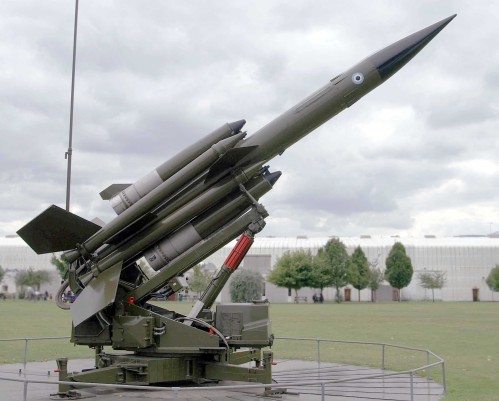A Bloodhound missile at the RAF Museum, Hendon, London.
British surface-to-air missile. One of the world’s most successful surface-to-air missiles, Bloodhound employs ramjets to achieve long range. First evidence that Britain had embarked on research in this direction came in 1952 when a ramjet test vehicle, JVT-1, was exhibited at the SBAC Show at Farnborough. Developed by the old Bristol Aeroplane company from an RAE Farnborough design, its purpose was to obtain information on the behaviour of the ramjet in free flight at supersonic speeds.
The wingless test vehicle had two 6-in (15. 2-cm) diameter propulsive ducts’ mounted at the tail on aerodynamic stubs. The centre body housed fuel, fuel-system controls and automatic measuring and radio- telemetry equipment. The JVT-1 was launched from a twin-railed ramp by a pair of 7.5-in (19-cm) cordite rockets which separated well above the speed of sound, leaving the ramjet sustainers to continue to accelerate the vehicle.
Development of Bloodhound proper (under the code name Red Duster) followed extensive tests with prototypes both in Britain and Australia. Bloodhound Mk 1 entered service with the Royal Air Force in 1958 and was subsequently ordered by Sweden and Australia. Bloodhound is ramp-launched by four Bristol Aerojet strap on boosters, each of which has a large fin to assist launch stability. The missile takes the form of a cylindrical body with a dielectric pointed nose housing the semi-active radar seeker. Thor ramjets of 16-in (40.6-cm) diameter are mounted above and below the rear fuselage and flight control is achieved by all-moving wings in conjunction with fixed rectangular tail fins. The wings can move together or differentially to achieve control on the ‘twist-and-steer’ principle.
The semi-active radar homing system responds to reflected radar energy from the target when illuminated by ground radar, and the high-explosive warhead is detonated by a proximity fuze. In the forepart of the body are flexible rubber tanks for kerosene fuel, pressurized by ram air from the rear.
So effective was the performance of the original missile that a Mk 2 has been supplied to the air forces of Switzerland, Australia and Singapore.
The Mk 2 has greatly improved performance and is more effective at lower altitudes. Not only is it air-transportable for rapid deployment overseas-in 1964 it was deployed in Malaysia-but it has a more powerful Thor ramjet, more powerful boosters, and continuous-wave radar guidance.
It would be wrong to suppose that this potent weapon system is limited to high and medium-altitude targets. Trials have shown that it can deal effectively with fast targets at altitudes below 305 m (1000 ft).
Bloodhound had an important role in the NATO defence of Western Europe. RAF No 25 Squadron operated Bloodhounds at Briiggen, Laarbruch and Wildenrath, whilst No 85 Squadron had home defence responsibilities in Suffolk, Norfolk, Lincolnshire and elsewhere.
(Bloodhound Mk 1)
Length (with boosters): 7.7 m (25 ft 3 in)
Diameter: 54.6 cm (21.5 in)
Range: 80-96 km (50-60 miles)
(Bloodhound Mk 2)
Length: 7.67 m
(25 ft 2 in); with boosters 8.45 m (27 ft 8 in)
Diameter: 54.6 cm (21.5 in)
Wing span: 2.83 m (9 ft 4 in)
Range: 96-161 km (60-100 miles)
Speed: Mach 2
Guidance: target-illuminating (CW) Ferranti ‘Firelight’, vehicle mounted, and GEC/AEI ‘Scorpion’
